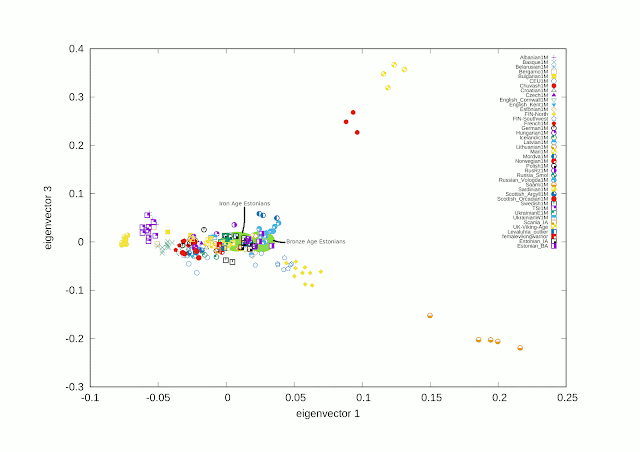Estonian BA
Estonian_BA V9_2 1060–850 BC R1a1’2
Estonian_BA V14_2 1280–1050 BC R1a1’2
Estonian_BA V16_1 730–390 BC R1a1’2
Estonian_BA X11_1 1030–890 BC R1a
Estonian_BA X14_1 780–430 BC R1a1c
Estonian_BA X20_1 900–800 BC R1a
Estonian IA
Estonian_IA V11_1 390–200 BC -
Estonian_IA V12_1 360–40 BC N3a3a
Estonian_IA VII3_1 380–180 BC ?
Estonian_IA VIII5_2 75–300 AD R1a
Estonian_IA VIII7_1 75–200 AD -
Estonian_IA VIII8_1 75–200 AD R1a1c
Estonian_IA VIII9_1 75–200 AD -
Update 9.12.2019 21:00
Now added a PCA plot figuring ancient Estonian N1c1 samples.
0LS10 Kunda Lääne-Viru, EST IA 770–430 BC M XY H13a1a1a N3a3 0 5
V12 Kurevere, Saare, EST IA 360–40 BC M XY I1a1c N3a3a
VII4 Vohma lääne-Viru, EST IA 760–400 BC M XY T1a1b N3a3a
IIa Karja, Saare, EST MA 1230–1300 AD M XY H3h1 N3a3a
IIf Otepää, Valga, EST MA 1360–1390 AD M XY T2b N3a3a
IIg Pada, Lääne-Viru, EST MA 1210–1230/1240 AD M XY U4a2b N3a3a
0LS10 drifts towards Siberian admixed groups and IIa drifts towards Finns and Saamis. Both deviants are however too weak to be considered as real migrants and their locations probably represent only admixture. All N1c1 samples are more comparable to those more western Iron Age Estonians than to more Baltic-like Bronze Age Estonians.



No comments:
Post a Comment
English preferred, because readers are international.
No more Anonymous posts.